Safety in Action
CPWR-NIOSH COVID-19 Webinar: Effectively Delivering Safety and Health Training During the COVID-19 Pandemic
Description:
The COVID-19 pandemic has caused rapid changes to safety and health training in the construction industry. In turn, trainers have quickly adjusted and innovated in delivering critical safety and health training while keeping trainees safe during the pandemic. How has distance learning evolved during this period, how does distance learning compare to face-to-face learning, and are these programs meeting their goals and objectives are questions addressed in a recent study. Join us to hear the results of the study and to get “tips and tools” for how to effectively deliver training while protecting workers during a pandemic.
Source: CPWR - The Center for Construction Research and Training
Date: 03/24/21
Guidance on Workplace Practices: Preventing spread of the virus through virtual fit testing utilizing irritant smoke.
Description:
This recommended procedure and guidance document were developed by West Virginia University Safety and Health Extension (WVUSHE)for conducting negative pressure respirator fit tests using irritant smoke during COVID-19 with remote assistance through Zoom. This work was undertaken in response to multiple requests related to products and providers. WVUSHE also provided those requesting help with information to assist with resource location and additional guidance for conducting qualitative fit tests.
Source: West Virginia University
Date: 03/04/21
Using a Barrier to Limit Airborne Exposure or Droplets
Description:
This image shows barriers that were used to protecttwo individuals who were required to work within close proximity (6 feet) of each other during week-long job installing underground cast iron piping in a trench. The 3’6”x 7’ droplet barrier wasfabricated using 6-millimeter plastic sheeting attached toa 2in x 4in lumber frame. Note: Workers should wear facing coverings even with the barrier.
Source: West Virginia University
Date: 03/12/21

Practicing social distancing during a training session
Description:
Boart Longyear Drilling Services mechanics practicing social distancing during a training session.
Photo credit: Alex Beseris
Source: Boart Longyear
Date: 09/19/20
Return to Work Safely (video)
Description:
This short video produced by the Massachusetts State Building Trades Council covers key points for working safely on construction sites including the importance of wearing N95 respirator masks, materials to pack to stay safe during the day, and the need for social distancing, hand washing, and staying home when sick. Watch this video for tips to protect yourself, your co-workers, family & others.
Source: Massachusetts Building Trades Council
Date: 09/11/20

Plexiglass Barrier
Description:
This photo shows use of plexiglass to create a physical barrier between workers when maintaining a 6ft distance is not possible.
Source: Oregon State Building Trades Council
Date: 08/28/20

Hand sanitizer station
Description:
A hand sanitizer station is provided to encourage hand hygiene on the job site, and the Safety Data Sheet provides information on the chemicals in the product as part of a hazard communication program.
Source: Oregon State Building Trades Council
Date: 09/11/20
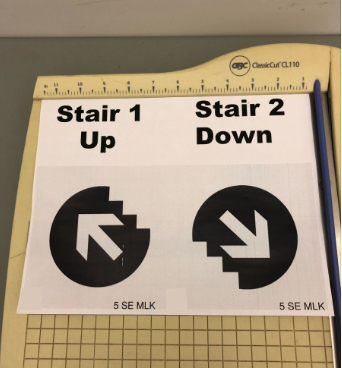
Designated stairs for up and down to promote social distancing
Description:
Segregated stair towers with signage reduce two-way traffic in stairwells and help workers maintain social distancing.
Source: Oregon State Building Trades Council
Date: 08/28/20

Sani-Cans (porta johns) positioned 6 feet apart with wash stations
Description:
Spread porta johns out to increase the physical distance between workers and provide easy access to hand washing or hand sanitizer stations to encourage hand hygiene.
Source: Oregon State Building Trades Council
Date: 08/28/20

Mark standing and walking areas to maintain social distancing
Description:
Workers maintain a 6 foot distance between each other while walking on the site and waiting in line. (View from a crane).
Source: Oregon State Building Trades Council
Date: 09/11/20
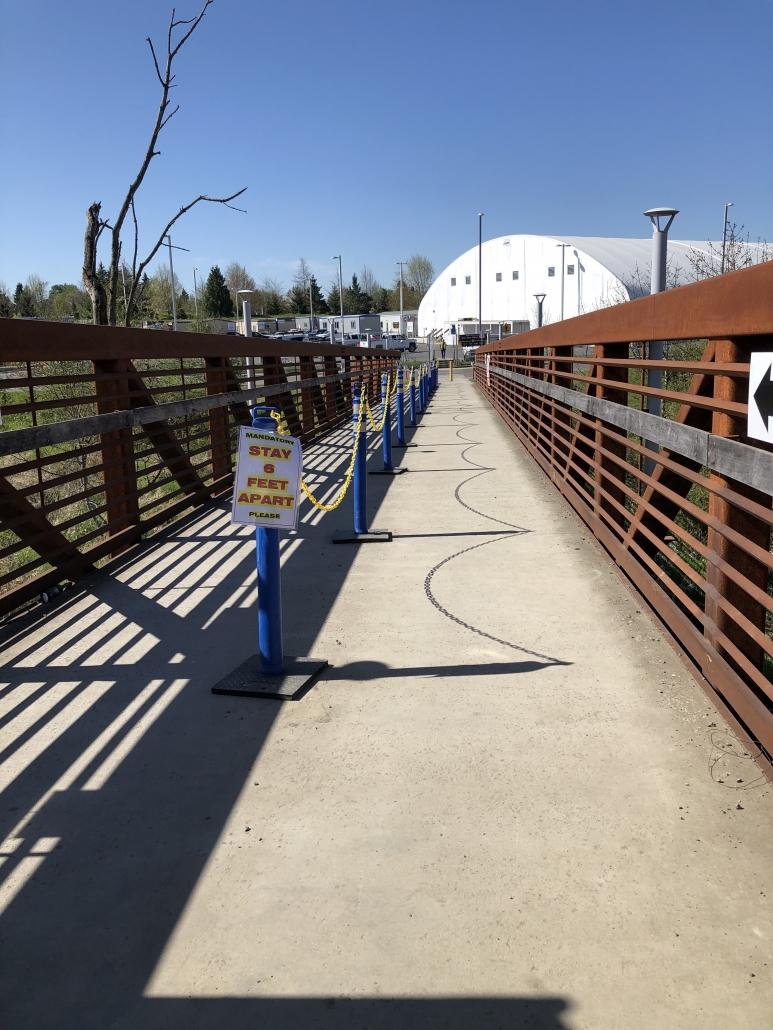
Signs indicate walking paths to maintain social distancing
Description:
Signage and segregated walk paths reduce two-way traffic on narrow paths, such as a bridge.
Source: Oregon State Building Trades Council
Date: 09/11/20
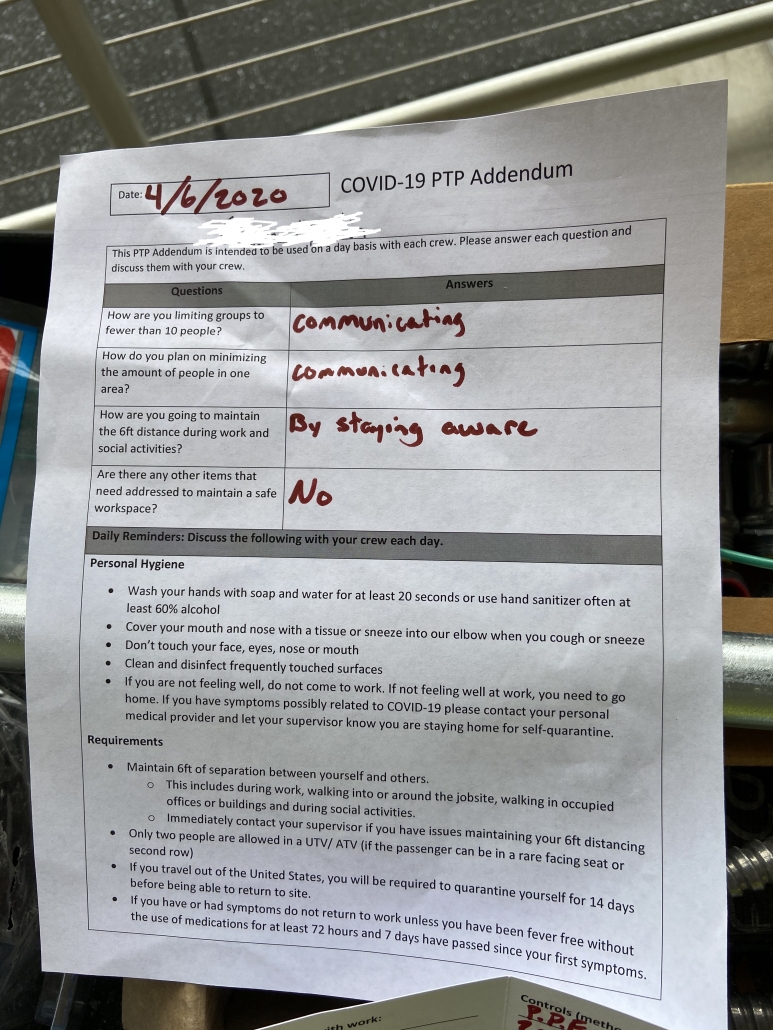
Checklist - Job Site Requirements
Description:
Checklist contains reminders to limit the number of people in an area and maintain social distancing as well as daily reminders on personal hygiene and other job site requirements related to COVID-19.
Source: Oregon State Building Trades Council
Date: 08/28/20
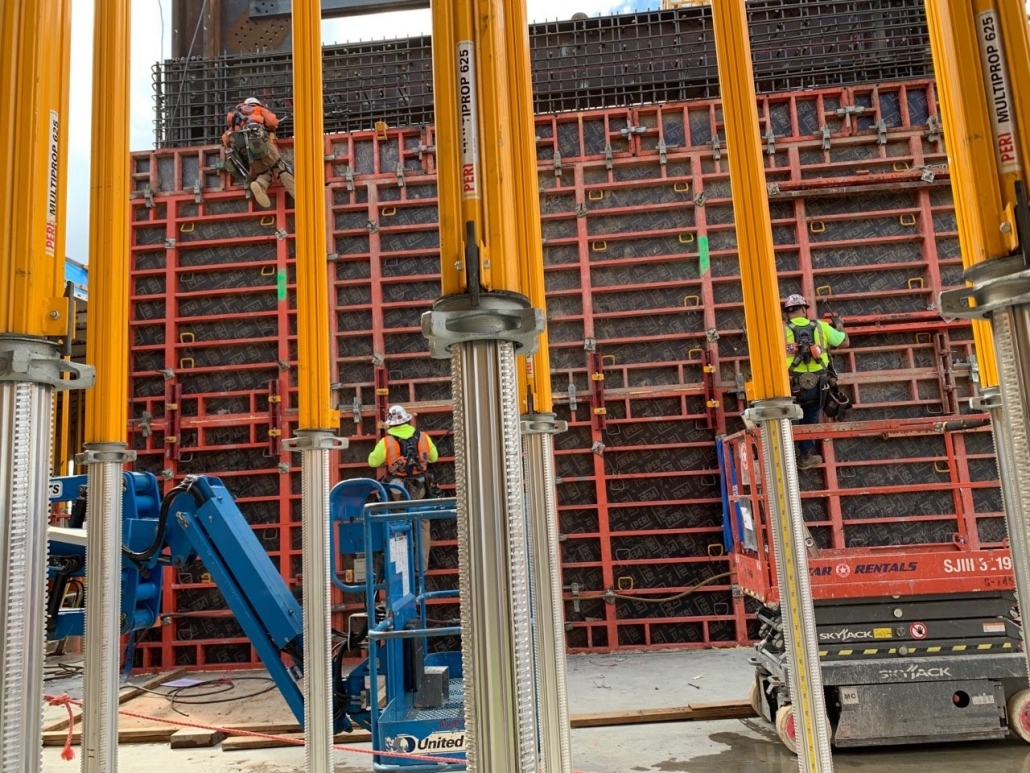
Adjust work to maintain social distancing - wall crew
Description:
This work layout and assignment of tasks creates a physical distance between workers.
Source: Oregon State Building Trades Council
Date: 08/28/20
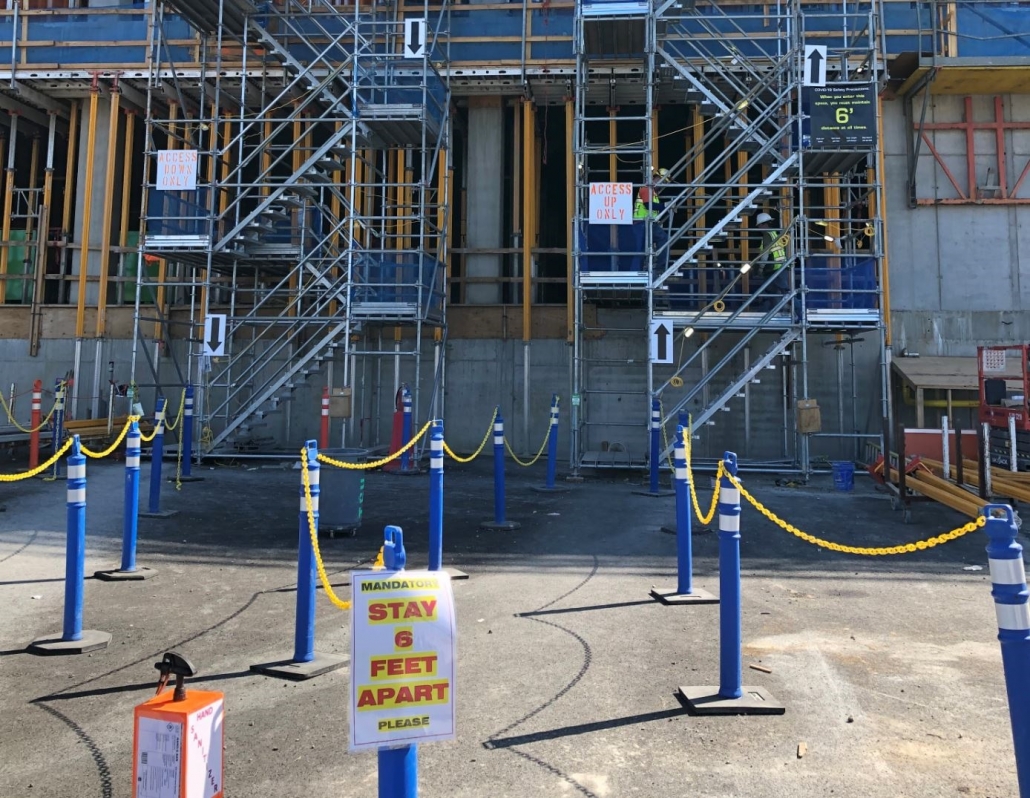
Signage, stair tower segregation and hand sanitizer stations
Description:
Signs, barriers, and segregated stair towers used to maintain social distancing and reduce two-way traffic in stairwells. Hand sanitizer stations placed in a high traffic area encourages hand sanitizing.
Source: Oregon State Building Trades Council
Date: 08/28/20

Signage and segregated walk path
Description:
Signs and segregated walk paths remind workers to stay 6 feet apart.
Source: Oregon State Building Trades Council
Date: 08/28/20
Alternative Hand Washing Stations
Description:
Images and tips on what to use to build hand washing stations.
Source: Brinkmann
Date: 08/28/20
Hotline for Worker COVID-19 Concerns
Description:
Provide an anonymous hotline number for workers on job sites to call if they have concerns or problems related to COVID. This may be workers concerned with compliance of policies, behaviors of other workers, or lack of policies to create a safe work environment. The hotline should insure anonymity of the caller but the option for a return call if possible. This may be run by a local construction organization, union, or volunteers who can forward concerns to relevant parties.
Source: Associated General Contractors of America: Missouri Chapter (AGCMO)
Date: 09/11/20
Preventing exposures from suppliers and outside employees during deliveries
Description:
All construction work depends on having an adequate supply of materials and appropriate equipment. During the pandemic, a delivery plan should be in place to explain who may enter the job site and where they may travel in order to reduce close contact and possible exposures to workers on the job site.
Source: Washington University in St. Louis
Date: 09/11/20
Reducing surface transmission of handling hard copies and papers through use of electronic devices
Description:
On construction sites, many meetings and information sessions share information in paper handouts and also use written signatures as evidence of attendance such as worker safety trainings. During COVID-19, this presents an issue of having workers touch the same objects (pen and paper). To eliminate spread by contact with papers, contractors may use alternative methods.
Source: Washington University in St. Louis
Date: 09/11/20
Job Site Breakroom Practices
Description:
It may be challenging to maintain physical distancing in breakrooms or break areas on a construction site.This document contains several steps to reduce the chance workers may get too close to each other, which is particularly important since facial coverings cannot be worn while actively eating and drinking.
Source: Washington University in St. Louis
Date: 09/11/20
Job Site Face Recognition Panel
Description:
Onsite temperature checks are conducted by some employers to screen for those with fever potentially due to the coronavirus. Infrared technology measures the infrared energy of objects and converts them to an electronic image that converts to the apparent surface temperature of the object being measured. This technology is used in handheld thermometers as well as through iPad devices using special software to read out the results.
Source: Interface Construction
Date: 08/28/20
Job Site Work Groups
Description:
This solution is to have workers stay with those who they work with to complete tasks and, if possible, who they travel with.
Source: Washington University in St. Louis
Date: 08/28/20

Job Site Health Screening
Description:
CDC recommends employers screen all workers before they enter a worksite occupied by other workers. Health screens should be completed each day. This document reviews what to consider when setting up a health screen.
Source: Clayco
Date: 08/28/20
COVID-19 Webinar Series: Safety in Action – An Example from the Job Site
Description:
This webinar focused on the steps taken by the Oregon COVID-19 Joint Construction Task Force, which includes labor, management (union and non-union), and government, and BAC Local 1 Oregon/Washington/Idaho/Montana and its signatory contractors to identify risks and implement interventions to prevent the spread of COVID-19 on construction sites and protect workers.
Source: CPWR - The Center for Construction Research and Training
Date: 09/11/20
Use of a Jobsite Monitor
Description:
For this solutio, a company designates one or more employees to walk the job site and monitor for compliance with COVID-19 policies and environmental protections. COVID-19 policies could include workers maintaining social distancing, using disinfectant and sanitation appropriately, such as in break areas, wearing face masks and other PPE appropriately, and helping with health screenings. They may also monitor supplies of disinfectant and hand sanitizer and availability, and location of signage. COVID-19 monitors may be more readily identified by wearing a colored vest or different colored hard hat or other different items.
Source: Alberici
Date: 09/11/20
.jpg)
Hands-Free Door Openers
Description:
This jobsite example demonstrates how to use equipment or install/adapt doors with hands free opener devices to eliminate the need to touch door handles. Doors may be opened using an automatic opening electrical mechanism or foot-operated device. Place signage close to the door to remind workers to use the foot operated control. Assess whether workers can operate the device without getting off-balance while carrying a large heavy load in their hands.
Source: Alberici
Date: 09/11/20
Form for Submitting Examples of Construction Stakeholders Reducing the Risk of COVID-19 Spread
Description:
Download a Word form to streamline submission of possible additions to this Clearinghouse.
Source: CPWR - The Center for Construction Research and Training
Date: 09/11/20
Safe Site Check-in App
Description:
A touchless app for checking workers into a job site.
Source: Safe Site Check In
Date: 09/11/20
Oregon COVID-19 Joint Task Force Resources
Description:
The Oregon COVID-19 Task Force is a joint industry partnership between union and non-union industry stakeholders, safety and health professionals, and government. It was initiated by the Oregon Building and Construction Trades Council to help the industry respond to the pandemic. This site, maintained by the Oregon Institute of Occupational Health Sciences, is being used to share the Task Forces' resources, best practices and innovations.
Source: Oregon Institute of Occupational Health Sciences
Date: 09/11/20
HITT COVID-19 Jobsite Resources
Description:
General COVID-19 FAQs Signage in English and Spanish with facts about COVID-19 and how to prevent the spread.
Source: HITT
Date: 08/28/20
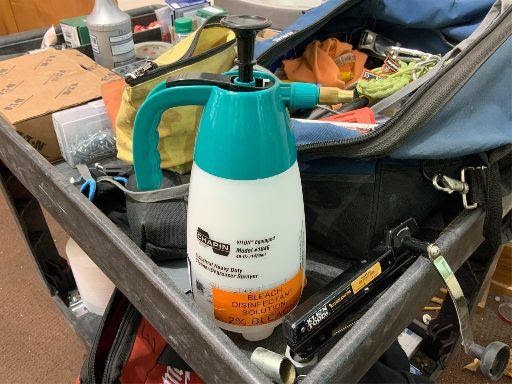
Trade partner tool cleaning apparatus
Description:
Trade partner tool cleaning apparatus -- tools are wiped down after use. Image courtesy of Pepper Construction of Indiana.
Source: Pepper Construction of Indiana
Date: 08/28/20
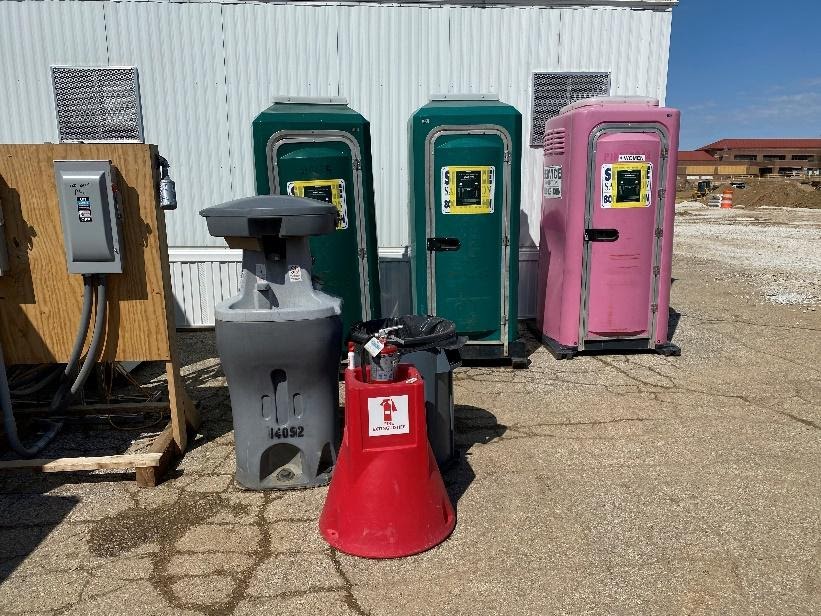
Portable handwashing station near port-a-lets
Description:
Pepper Construction added handwashing stations near port-o-lets. Image courtesy of Pepper Construction of Indiana.
Source: Pepper Construction of Indiana
Date: 08/28/20
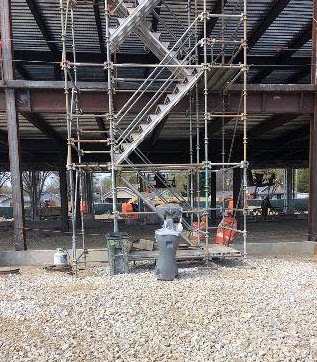
Handwashing station in a high traffic area
Description:
A handwashing station in a high traffic area on a job site. Image courtesy of Pepper Construction of Indiana.
Source: Pepper Construction of Indiana
Date: 08/28/20
ASSP - COVID-19 Challenges: Construction and Demolition Operations (May 27, 2020)
Description:
Insights from a panel of construction and demolition experts on best practices employers can implement to prevent COVID-19 exposure on work sites, address worker concerns, and create a culture of safety.
Source: American Society of Safety Professionals (ASSP)
Date: 09/11/20
Temporary foot-operated wash hand station
Description:
Cheap, quick, temporary foot operated wash hand station -- includes short video.
Source: Tim Main, British Contracts Manager
Date: 08/28/20
ENR - Industry Finds New Innovations to Stay Ahead of COVID-19 (April 15, 2020)
Description:
This article provides examples of ways the industry is responding to the need for hand washing stations and social distancing.
Source: Engineering News Record (ENR)
Date: 05/04/20